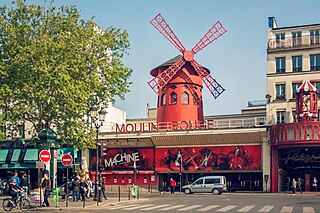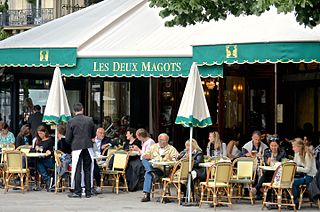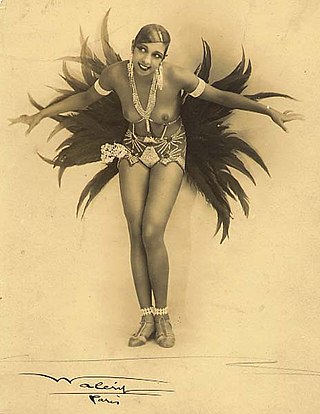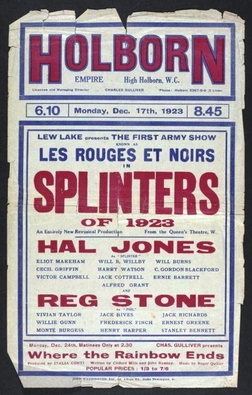Related Research Articles

Moulin Rouge is a cabaret in Paris, on Boulevard de Clichy, at Place Blanche, the intersection of, and terminus of Rue Blanche.

Cabaret is a form of theatrical entertainment featuring music, song, dance, recitation, or drama. The performance venue might be a pub, a casino, a hotel, a restaurant, or a nightclub with a stage for performances. The audience, often dining or drinking, does not typically dance but usually sits at tables. Performances are usually introduced by a master of ceremonies (M.C.). The entertainment, as performed by an ensemble of actors and according to its European origins, is often oriented towards adult audiences and of a clearly underground nature. In the United States, striptease, burlesque, drag shows, or a solo vocalist with a pianist, as well as the venues which offer this entertainment, are often advertised as cabarets.

The 6th arrondissement of Paris is one of the 20 arrondissements of the capital city of France. In spoken French, it is referred to as le sixième.

Pigalle is an area in Paris, France, around the Place Pigalle, on the border between the 9th and the 18th arrondissements. It is named after the sculptor Jean-Baptiste Pigalle (1714–1785).

The Folies Bergère is a cabaret music hall in Paris, France. Located at 32 Rue Richer in the 9th Arrondissement, the Folies Bergère was built as an opera house by the architect Plumeret. It opened on 2 May 1869 as the Folies Trévise, with light entertainment including operettas, comic opera, popular songs, and gymnastics. It became the Folies Bergère on 13 September 1872, named after nearby Rue Bergère. The house was at the height of its fame and popularity from the 1890s' Belle Époque through the 1920s.

Vavin is a station of the Paris Métro on line 4 on the border of the 6th arrondissement and 14th arrondissement, under Place Pablo-Picasso at the intersection of Boulevard du Montparnasse and Boulevard Raspail. It is named after the nearby rue Vavin, named after 19th-century statesman Alexis Vavin (1792-1863).

The Hôtel de Rambouillet, formerly the Hôtel de Pisani, was the Paris residence of Catherine de Vivonne, marquise de Rambouillet, who ran a renowned literary salon there from 1620 until 1648. It was situated on the west side of the rue Saint-Thomas-du-Louvre, just north of Marie de Rohan's Hôtel de Chevreuse, in a former quarter of Paris, located between the Louvre and Tuileries palaces, near the then much smaller Place du Carrousel, in the area of what was to become the Pavillon Turgot of the Louvre Museum.

Le Lido is a musical theatre venue located on the Champs-Élysées in Paris, France. It opened in 1946 at 78 Avenue des Champs-Élysées and moved to its current location in 1977. Until its purchase by Accor in 2021, it was known for its exotic cabaret and burlesque shows including dancers, singers, and other performers. Famous names have performed there including: Edith Piaf, Siegfried and Roy, Hervé Vilard, Sylvie Vartan, Ray Vasquez, Renee Victor, Johnny Hallyday, Maurice Chevalier, Marlene Dietrich, Eartha Kitt, Josephine Baker, Kessler Twins, Elton John, Laurel & Hardy, Dalida, Shirley MacLaine, Mitzi Gaynor, Juliet Prowse, and Noël Coward.

Pierre-François-Léonard Fontaine was a French neoclassical architect, interior decorator, designer and artist.

Jacqueline Charlotte Dufresnoy, better known by her stage name Coccinelle, was a French cabaret entertainer, singer, actress, entertainer, singer, and transgender activist. A transgender woman, she was the first widely publicized celebrity to undergo gender reassignment in Europe, making medical, legal and religious history. Coccinelle was an international celebrity and a renowned club singer, styled as a blonde bombshell sex symbol in the vein of Marilyn Monroe and Bridgette Bardot.

The Paradis Latin is a theater at number 28, rue du Cardinal Lemoine, in the Latin Quarter of Paris, in the fifth arrondissement, near Notre-Dame, the Panthéon, and the Tour d'Argent restaurant. The closest métro stations are Cardinal Lemoine and Jussieu.

The Place du Carrousel is a public square in the 1st arrondissement of Paris, located at the open end of the courtyard of the Louvre Palace, a space occupied, prior to 1883, by the Tuileries Palace. Sitting directly between the museum and the Tuileries Garden, the Place du Carrousel delineates the eastern end of the gardens just as the Place de la Concorde defines its western end.

The Casino de Paris, located at 16, rue de Clichy, in the 9th arrondissement, is one of the well known music halls of Paris, with a history dating back to the 18th century. Contrary to what the name might suggest, it is a performance venue, not a gambling house. The closest métro/RER stations are Liège, Trinité–d'Estienne d'Orves, and Haussmann–Saint-Lazare.
Le Bœuf sur le toit 'The Ox on the Roof' is a celebrated cabaret-bar in Paris, founded in 1921 by Louis Moysés. It was originally located at 28, rue Boissy d'Anglas in the city’s 8th arrondissement. It was notably the gathering place for the avant-garde arts scene during the period between the wars. Maurice Sachs chronicled it in his 1939 book Au temps du Bœuf sur le toit. Currently it is located at 34, rue du Colisée, having moved five times within the 8th arrondissement. The current building dates from the 18th century.
A vedette is the main female artist of a show derived from cabaret and its subcategories of revue, vaudeville, music hall or burlesque. The purpose of the vedette is to entertain and captivate the public. Vedettes are expected to sing, dance and act on stage. Particularly accomplished artistes are considered super vedettes or first vedettes. Vedettes often appear alongside groups of dancers, flashy and revealing costumes, magicians, comedians, jugglers, or even performing animals. Vedettes specializing in burlesque generally do striptease and may also perform nude on stage.

The Années folles was the decade of the 1920s in France. It was coined to describe the social, artistic, and cultural collaborations of the period. The same period is also referred to as the Roaring Twenties or the Jazz Age in the United States. In Germany, it is sometimes referred to as the Golden Twenties because of the economic boom that followed World War I.

Madame Arthur opened in 1946 as the first gender-twist cabaret in France, which took its name from the famous song written in 1860 by Paul de Kock and performed by Yvette Guilbert.

The Théâtre de l'Étoile was a theatre located at 136 Avenue des Champs-Élysées in the 8th arrondissement of Paris. It was built in 1923 and operated as a theatre until 1926. It is not to be confused with a completely unrelated theatre, also called Théâtre de l'Étoile, which operated from 1928 to 1964 on the Avenue Wagram.

Guilda was the stage name of Jean Guida, a French and Canadian drag queen who built a long and sustained career as a cabaret and variety entertainer.

Splinters was a popular theatrical revue that ran in several versions in Britain between the First World War and the 1930s. It featured female impersonators, and men cross-dressing as women, and was originally developed in the First Army by a concert party, Les Rouges et Noirs. A film version was made in 1929, with sequels.
References
- 1 2 3 "La fabuleuse histoire du cabaret le Carrousel de Paris" (in French). 2015-02-19. Archived from the original on 2015-02-19.
- ↑ Senelick, Laurence (2000). The changing room : sex, drag, and theatre. London: Routledge. pp. 359–361. ISBN 0-415-10078-X. OCLC 42752641.
- 1 2 Pruvot, Marie-Pierre. "Le Grand Carrousel". Marie-Pierre Pruvot - Bambi (in French). Retrieved 2023-05-02.
- ↑ Vazquez Diaz, Ricardo (March 18, 2022). Una isla sonora: auralidad, literatura y política en la obra escrita y radial de Severo Sarduy (Cuba, 1937-Francia, 1993) (PDF) (PhD) (in Spanish). University of Pittsburgh Dietrich School of Arts and Sciences. pp. 114–115. Retrieved 2023-05-02.